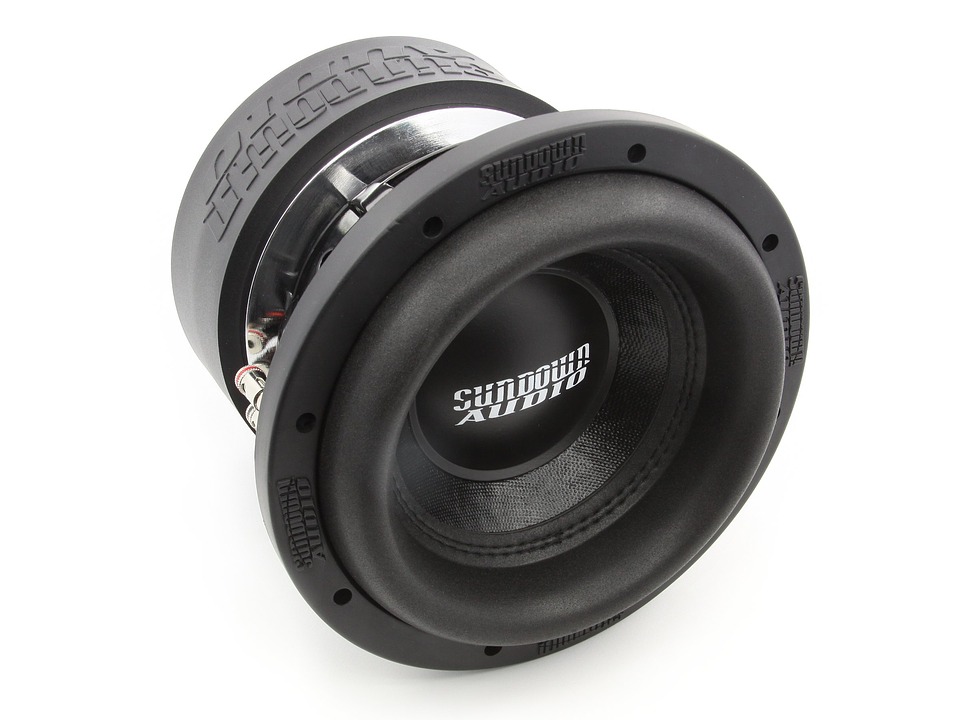Bring the Bass with a Car Subwoofer

Maybe not the car subwoofer you were thinking of?
Learn How to Choose, Set Up, and Tune a Car Subwoofer for Your Stereo System
Are you frustrated by your car stereo’s bass response, or lack thereof?
You’re not alone. Bass frequencies, while generally fine with most modern car speakers and upgraded speakers, are often that special something that makes the difference between a good car stereo and a great one.
Bass is like an anchor that ties rhythm and melody together, and if you feel like upgraded speakers still aren’t giving you the rumble you want, then it’s time to start looking at car subwoofer options.
Subwoofers bring car stereo systems together, working with a head unit and speakers to add deep, rich bass to your stereo’s sound.
Whether you’re into the latest EDM, classic rock, classical, or jazz, a good car subwoofer will drastically improve your listening experience.
Finding the right subwoofer for your vehicle depends on several factors, including budget and how much space you have in your vehicle.
Your Ottawa car stereo experts at AudioMotive have put together some of the best tips to keep in mind when considering sub installations, starting with how a subwoofer works.
How do Car Subwoofers Work?
Subwoofers are large speakers that reproduce low frequencies (bass), typically designed to handle the frequency range between 20 and 200 Hz.
Because they’re larger speakers, they move a bit more air and can easily replicate lower frequency sounds. Generally speaking, the bigger the subwoofer, the bigger the bass.
However, it’s not just the size that counts – it’s how you use it. Simply adding a subwoofer won’t guarantee high-quality bass sounds.
How you place your subwoofer in your car, what enclosure you use, and the speaker size are all big contributors to good bass frequencies in your car stereo system.
Understanding Enclosures
Sub enclosures are boxes that hold subwoofers. What sort of enclosure you mount your subwoofer in helps determine sound quality and frequency range.
Sealed sub boxes produce the deepest and most frequency-accurate sound. Sometimes, smaller subs in sealed enclosures can produce deeper bass than larger subs in open enclosures.
Ported and bandpass enclosures produce bass that isn’t as deep as the bass from sealed enclosures, but these typically produce louder sound.
If you have a tightly sealed trunk, and you don’t plan to use most of its space, you may also want to consider a subwoofer that doesn’t have a sub box. Instead, it is mounted to a board and installed in your trunk, and your trunk acts as the enclosure.
Let’s take a closer look at some of the types of subwoofers available for your car stereo system.

An example of a car subwoofer outside an enclosure.
Component Subs
These subs are ideal if you are custom building your own car stereo system. A component sub is just the speaker, no enclosure, and it will need to be installed in a box to produce the best sound.
Component subs also require power from external amplifiers.
These subs come in various sizes, from 8 inches to 15 inches. Different models operate on low or high power and in different box types. So you can find a component sub to match your custom stereo system design.
Enclosed Subs
These subs come pre-mounted in a sub box for an easy, off-the-shelf combo. Enclosed subs also need external amps for power.
Since these take away the guesswork of choosing an enclosure for a sub, enclosed subs are ideal for those who don’t want to spend much time designing their own system.
Powered Subs
To save space in your car, powered subs are the way to go. Powered subs combine the subwoofer and amplifier in a single enclosure. This means you won’t have to find space for your amp.
Furthermore, powered subs are easy to install and relatively compact compared to other subs. Their smaller size, drivers, and amplifiers may not provide as much sound power as larger subs, but they are still effective bass producers.
Vehicle-Specific Subs
Vehicle-specific subs are designed to blend into your car’s interior without taking up extra space. They usually match the vehicle’s interior colour, and are designed to fit in out-of-the-way locations in cars, trucks, and SUVs.
These subs come powered and unpowered, and may not produce the biggest bass compared to larger subs. But they still produce sufficient bass with the added benefit of saving space.
How Much Power Do You Need?
The more power your sub has, the more volume your system will create.
But understanding what power requirements your system requires means understanding a few key terms.
RMS
RMS power ratings refer to continuous power handling, derived from root-mean-square calculations. In simpler terms, RMS values are indications of how much current a speaker can handle over a long term.
The higher the value, the more output your speaker can handle, and in theory the more bass.
However, it’s important to match your subwoofer’s RMS power handling with an amp or head unit’s power output for optimal results.
Sensitivity
A sub’s sensitivity rating is expressed as a sound pressure level (SPL) value. This value relates to how much power a sub needs to produce a given volume.
Subs with high SPL ratings have higher sensitivity. These subs don’t need as much power to produce high volumes, compared to subs with low SPL ratings.
As such, if your head unit or amp has a low power, you’ll want a subwoofer with a high sensitivity (SPL) rating.

Your amp or head unit will largely determine power concerns for your sub of choice.
Matching Your Sub with An Amplifier
Since an amplifier is what powers your sub, it’s kind of important to have one!
To get the most out of your car stereo system, your new sub should match your external amplifier or head unit amplifier in terms of power, impedance, and sensitivity.
Power and Impedance
Your subwoofer’s power handling must match your amp’s power output. The power handling and output are rated in RMS.
Subwoofer impedance is rated in ohms, and refers to the electrical resistance of the sub.
Besides matching the power rating of an amp, your subs must also match an amp’s impedance rating.
While most subs are rated at 4 ohms impedance, you can also find 2-ohm, 8-ohm, and dual voice coil subwoofers.
Dual voice coil (DVC) subwoofers provide more flexibility for wiring sound systems.
While typical subwoofers have a single voice coil, DVC subwoofers have two separate coils with their own connections. And these two voice coils are mounted on one cylinder and are connected to a shared cone.
Sensitivity
As mentioned earlier, if you have a low- or under-powered amp, choose a subwoofer with a high sensitivity rating. And if you have a high-powered amp, your sub won’t need to have a high sensitivity rating.

Tuning your stereo to optimize sub performance is a must.
Tuning Tips for Optimal Sound
So you’ve got your subwoofer installed and ready to go.
But wait! There’s still one last thing to do.
Tuning your amplifier to get the best sound from your sub and car stereo system as a whole shouldn’t be overlooked.
Not sure where to start? We’ve got you covered.
Remove Distortion
Play music with the amp gain set low and turn up the volume until you hear distortion. Turn down the volume until the music sounds clear again. Take note of this volume setting since it is the maximum volume your receiver can reach while still playing clearly.
If you have an amp, turn up the amp’s gain until you hear distortion. Then slowly turn down the gain until the distortion is gone. Leave the amp gain at this level.
Flatten the Signal and Open the Low-Pass Filter
Turn your sub’s amp gain to the lowest level (counter-clockwise). Switch on its low-pass filter and set this as high as possible (clockwise). Turn off bass boost and set the remote level control to the middle position (if applicable).
On your head unit, adjust the bass tone control to the middle, zero, or flat setting, and set the subwoofer level control to its middle or no gain setting (if applicable).
Turn off any bass boost, crossover, and low-pass filters on the head unit. Never turn these settings on both the head unit and amplifier at the same time! You should only use these settings on one component.
Adjust the Subwoofer Gain and Low-Pass Filter
Next, playing music at one-quarter volume, turn up the subwoofer amp’s gain until the subwoofer’s sound completely overpowers the other speakers (without distorting).
Slowly adjust the sub amp’s low-pass filter down until the high- and mid-frequency notes disappear from the music coming from the sub. Filter out vocals, cymbals, strings, and guitars, and leave only the bass and low drums.
Adjust the Bass Boost and Subsonic Filter
Now it’s time to adjust these optional filters, assuming your sub has them.
If your sub has bass boost, slowly turn it up to hear what it sounds like. Be careful as bass boost can bring distortion quite quickly.
If you hear distortion, lower the sub amp’s gain until the distortion goes away.
If you have a ported subwoofer, use a subsonic filter on your amp to reduce overly loud low notes. You can fine-tune all the filters to suit your preferences. Once you’re satisfied, turn the amp’s gain down completely.
Match the Subwoofer Level to the Receiver Volume
Finally, it’s time to turn up the head unit’s volume to the maximum distortion-free level.
Slowly turn up the sub amp’s gain until the bass is balanced with the rest of the musical frequencies.
Move the remote bass boost or level control up and down slightly to hear what happens.
If your bass has loud volume but not enough depth, try reversing your sub’s speaker leads. Fine-tuning your stereo system’s EQ and responsiveness takes time and patience to get just right.
Still unclear on subwoofers? We’ve got the answers and advice you need right here at AudioMotive. Installing a subwoofer can help add serious bottom-end to your stereo, letting you enjoy full, rich audio on the road. You’re going to love turning things up!
